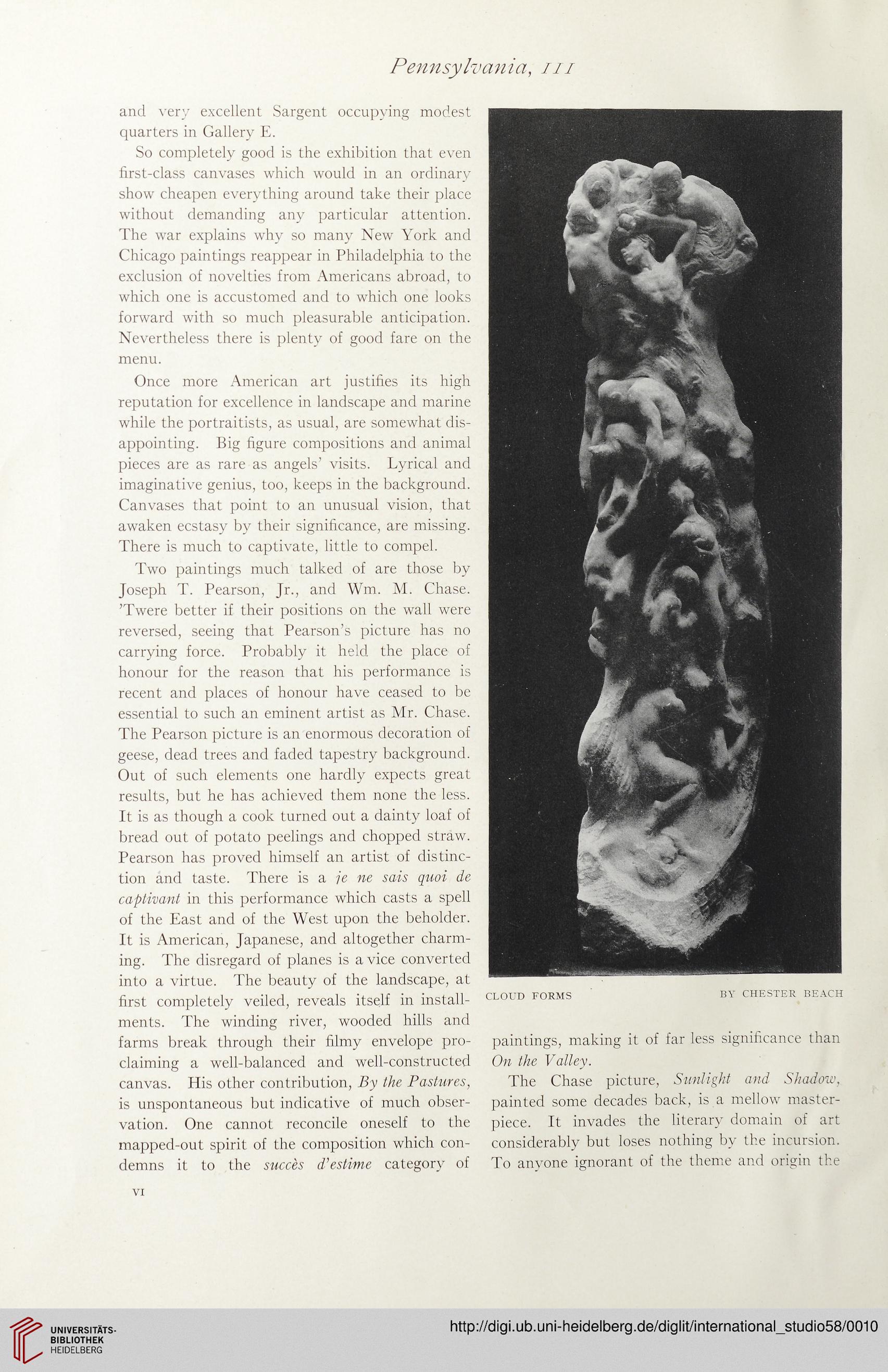Pennsylvania, ni
and very excellent Sargent occupying modest
quarters in Gallery E.
So completely good is the exhibition that even
first-class canvases which would in an ordinary
show cheapen everything around take their place
without demanding any particular attention.
The war explains why so many New York and
Chicago paintings reappear in Philadelphia to the
exclusion of novelties from Americans abroad, to
which one is accustomed and to which one looks
forward with so much pleasurable anticipation.
Nevertheless there is plenty of good fare on the
menu.
Once more American art justifies its high
reputation for excellence in landscape and marine
while the portraitists, as usual, are somewhat dis-
appointing. Big figure compositions and animal
pieces are as rare as angels’ visits. Lyrical and
imaginative genius, too, keeps in the background.
Canvases that point to an unusual vision, that
awaken ecstasy by their significance, are missing.
There is much to captivate, little to compel.
Two paintings much talked of are those by
Joseph T. Pearson, Jr., and Wm. M. Chase.
’Twere better if their positions on the wall were
reversed, seeing that Pearson’s picture has no
carrying force. Probably it held the place of
honour for the reason that his performance is
recent and places of honour have ceased to be
essential to such an eminent artist as Mr. Chase.
The Pearson picture is an enormous decoration of
geese, dead trees and faded tapestry background.
Out of such elements one hardly expects great
results, but he has achieved them none the less.
It is as though a cook turned out a dainty loaf of
bread out of potato peelings and chopped straw.
Pearson has proved himself an artist of distinc-
tion and taste. There is a je ne sais quoi de
captivant in this performance which casts a spell
of the East and of the West upon the beholder.
It is American, Japanese, and altogether charm-
ing. The disregard of planes is a vice converted
into a virtue. The beauty of the landscape, at
first completely veiled, reveals itself in install-
ments. The winding river, wooded hills and
farms break through their filmy envelope pro-
claiming a well-balanced and well-constructed
canvas. His other contribution, By the Pastures,
is unspontaneous but indicative of much obser-
vation. One cannot reconcile oneself to the
mapped-out spirit of the composition which con-
demns it to the succes d’estime category of
CLOUD FORMS BY CHESTER BEACH
paintings, making it of far less significance than
On the Valley.
The Chase picture, Sunlight and Shadow,
painted some decades back, is a mellow master-
piece. It invades the literary domain of art
considerably but loses nothing by the incursion.
To anyone ignorant of the theme and origin the
VI
and very excellent Sargent occupying modest
quarters in Gallery E.
So completely good is the exhibition that even
first-class canvases which would in an ordinary
show cheapen everything around take their place
without demanding any particular attention.
The war explains why so many New York and
Chicago paintings reappear in Philadelphia to the
exclusion of novelties from Americans abroad, to
which one is accustomed and to which one looks
forward with so much pleasurable anticipation.
Nevertheless there is plenty of good fare on the
menu.
Once more American art justifies its high
reputation for excellence in landscape and marine
while the portraitists, as usual, are somewhat dis-
appointing. Big figure compositions and animal
pieces are as rare as angels’ visits. Lyrical and
imaginative genius, too, keeps in the background.
Canvases that point to an unusual vision, that
awaken ecstasy by their significance, are missing.
There is much to captivate, little to compel.
Two paintings much talked of are those by
Joseph T. Pearson, Jr., and Wm. M. Chase.
’Twere better if their positions on the wall were
reversed, seeing that Pearson’s picture has no
carrying force. Probably it held the place of
honour for the reason that his performance is
recent and places of honour have ceased to be
essential to such an eminent artist as Mr. Chase.
The Pearson picture is an enormous decoration of
geese, dead trees and faded tapestry background.
Out of such elements one hardly expects great
results, but he has achieved them none the less.
It is as though a cook turned out a dainty loaf of
bread out of potato peelings and chopped straw.
Pearson has proved himself an artist of distinc-
tion and taste. There is a je ne sais quoi de
captivant in this performance which casts a spell
of the East and of the West upon the beholder.
It is American, Japanese, and altogether charm-
ing. The disregard of planes is a vice converted
into a virtue. The beauty of the landscape, at
first completely veiled, reveals itself in install-
ments. The winding river, wooded hills and
farms break through their filmy envelope pro-
claiming a well-balanced and well-constructed
canvas. His other contribution, By the Pastures,
is unspontaneous but indicative of much obser-
vation. One cannot reconcile oneself to the
mapped-out spirit of the composition which con-
demns it to the succes d’estime category of
CLOUD FORMS BY CHESTER BEACH
paintings, making it of far less significance than
On the Valley.
The Chase picture, Sunlight and Shadow,
painted some decades back, is a mellow master-
piece. It invades the literary domain of art
considerably but loses nothing by the incursion.
To anyone ignorant of the theme and origin the
VI




